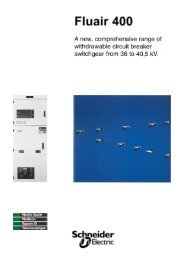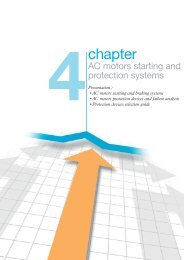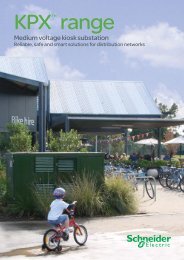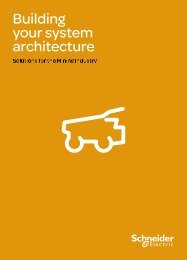Connect - Schneider Electric
Connect - Schneider Electric
Connect - Schneider Electric
Create successful ePaper yourself
Turn your PDF publications into a flip-book with our unique Google optimized e-Paper software.
DESCRIPTION OF THE GROUP, AND ITS STRATEGY, MARKETS AND BUSINESSES<br />
ORGANISATIONAL SIMPLICITY AND EFFICIENCY<br />
4.2 A more modular approach to information systems<br />
In 2011 <strong>Schneider</strong> <strong>Electric</strong> continued with the redesign of its<br />
IT strategy, in order to gradually roll out a common model aimed at<br />
simplifying and standardising operations. This model is developing<br />
towards a more open architecture, capable of deploying faster and<br />
less inter-dependent IT platforms to allow for easier upgrades at a<br />
lower cost.<br />
Four platforms are being rolled out for employee management,<br />
customer relations, back-offi ce functions and R&D support systems.<br />
The gradual roll out of an SAP-based information system known<br />
as “bridge” is now focused on back-offi ce functions. After pilot<br />
testing in India, Hungary, Austria, Croatia, Romania, Slovakia and<br />
Slovenia, in 2011 the bridge core system has continued to be rolled<br />
out various countries and entities. The roll out will continue in 2012.<br />
This thinking at Group level was facilitated by the globalisation of<br />
information systems within a single IT function created in 2009 that<br />
has a governance role and provides services internally. This move<br />
towards globalisation mainly involved:<br />
• gradually deploying a single IT Department that serves all<br />
businesses and users within <strong>Schneider</strong> <strong>Electric</strong> in a uniform<br />
manner. To achieve this, the most qualifi ed and competitive<br />
providers – both internal and external – will be used as needed;<br />
• gradually setting up a global IT infrastructure (networks, data<br />
centres, distributed computing and help desk) that is independent<br />
of the various managerial lines and that makes the most of the<br />
Group’s critical size and accumulated experience.<br />
4.3 Worldwide redeployment of production and supply chain resources<br />
<strong>Schneider</strong> <strong>Electric</strong> has more than 260 production sites and<br />
110 distribution centres around the world for whom customer<br />
satisfaction is the top priority.<br />
While working constantly to improve occupational health and safety<br />
and environmental protection, the Group’s manufacturing policy<br />
aims to fulfi l four key objectives (listed in order of importance):<br />
1. deliver a level of quality and service that meets or exceeds<br />
customer expectations;<br />
2. achieve competitive product costs and keep increasing<br />
productivity;<br />
3. develop the speed and effi ciency of the system and limit<br />
production sites’ risk exposure (currency parity, geopolitical risks<br />
and changes in cost factors);<br />
4. optimise capital employed in manufacturing operations.<br />
A number of the production facilities and distribution centres are<br />
dedicated to the global market. The other units are located as<br />
close as possible to their end markets. Although design and/or<br />
aesthetic features may be adapted to meet local requirements,<br />
<strong>Schneider</strong> <strong>Electric</strong> standardises key components as much as<br />
possible. This global/local approach helps <strong>Schneider</strong> <strong>Electric</strong><br />
maximise economies of scale and optimise profi tability and<br />
service quality.<br />
Drawing on its global scope, the Group has re-balanced and<br />
optimised its manufacturing and supply chain resources. The Group<br />
launched a new stage in its industrial deployment in 2010. As part<br />
of the Group’s new organisation, the Power business production<br />
and supply chain resources have been globalised and combined<br />
under a single organisation, with global operating responsibility.<br />
Previously, these resources were organised by region and reported<br />
to the various Operating Divisions.<br />
In Western Europe, the United States, Japan and Australia,<br />
rightsizing plans continued to be deployed with a focus on<br />
specialising production and supply chain units and reducing the<br />
number of sites.<br />
Continuous improvement on a global scale<br />
At the same time, an industrial excellence programme called<br />
<strong>Schneider</strong> Production System (SPS) has been rolled out in all<br />
plants to substantially and continuously improve service quality<br />
and productivity. The programme also takes environmental criteria<br />
into account. Based on a lean manufacturing approach, SPS is<br />
supported by the extension of Six Sigma and Quality and Value<br />
Analysis programmes across the Group. By deploying these<br />
optimisation methods globally and sharing best practices, the<br />
Group intends to lift the operational performance of all its plants to<br />
the same high standard.<br />
<strong>Schneider</strong> <strong>Electric</strong>’s plants and products comply with increasingly<br />
extensive and stringent European regulations and with international<br />
standards governing environmental protection in all host countries.<br />
In many cases, the Group anticipates future standards. In 1992,<br />
<strong>Schneider</strong> <strong>Electric</strong> defi ned a formal environmental policy, which was<br />
revised in 2004 to take account of changes both inside and outside<br />
the Group. This policy is designed to improve production processes,<br />
promote eco-design, integrate customer expectations into the<br />
Group’s environmental protection approach and raise awareness<br />
among all employees and partners about environmental protection<br />
and energy effi ciency. In order to limit risks related to the environment<br />
generally, the Group has implemented an ISO 14001-compliant<br />
process to continuously improve the environmental performance of<br />
its plants and supply chain centres.<br />
External environmental audits were implemented in 2011 that were<br />
responsible for validating this process as well as for the consistency<br />
of assessments.<br />
The segmented response to customers’ needs<br />
Since 2011, a new approach to progress was initiated in terms<br />
of the search for responses that were better adapted to industrial<br />
operation for each customer segment (distributers, partners, panel<br />
builders, etc.).<br />
2011 REGISTRATION DOCUMENT SCHNEIDER ELECTRIC<br />
33<br />
1

















